 |
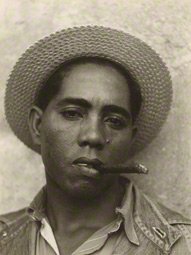
 |
 |
Stevedore, Walker Evans, 1933. The J. Paul Getty Museum. © Walker Evans Archive, The Metropolitan Museum of Art
|
 |
 |
|
Cuba's attempt to forge an independent state has been a project under development for more than 100 years and a source of fascination for nations, intellectuals, and artists alike.
A Revolutionary Project: Cuba from Walker Evans to Now looks at three critical periods in the nation's history as witnessed by photographers before, during, and after the country's 1959 Revolution. The exhibition juxtaposes Walker Evans's 1933 images from the end of the Machado dictatorship with views by contemporary foreign photographers Virginia Beahan, Alex Harris, and Alexey Titarenko, who have explored Cuba since the withdrawal of Soviet support in the 1990s.
A third section bridging these two eras presents pictures by Cuban photographers who participated in the 1959 Revolution, including Alberto Korda, Perfecto Romero, and Osvaldo Salas.
|
 |
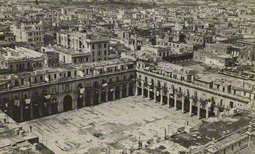
 |
 |
View of Havana (Plaza del Vapor, Market Area, Havana), Walker Evans, 1933. The J. Paul Getty Museum. © Walker Evans Archive, The Metropolitan Museum of Art
|
 |
 |
|
|
 |
Walker Evans is one of the photographers most responsible for the way we now imagine American life in the 1930s. His distinctive photographic style, which he declared "transcendent documentary," was nurtured by New York in the late 1920s, but it was fully formed by his experience in another country—Cuba—in 1933.
In the spring of that year, Evans was asked by publisher J. B. Lippincott to produce a body of work about Cuba to accompany a book by the radical journalist Carleton Beals. This book, The Crime of Cuba, would be a scathing indictment of the then-current regime of Cuban President Gerardo Machado. He came into office in 1925, supported by the U.S. government, but became more dictatorial as the full force of the global depression hit Cuba. Evans wrote to a friend that he arrived in May "in the midst of a revolution." After years of civil strife in the country, Machado was forced from office in August, less than two months after Evans departed.
|
 |
 |
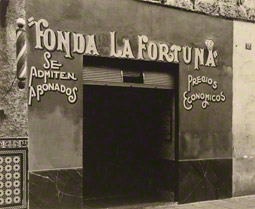
 |
 |
Small Restaurant, Havana, Walker Evans, 1933. The J. Paul Getty Museum. © Walker Evans Archive, The Metropolitan Museum of Art
|
 |
Evans made substantial strides in his photographic practice during the weeks in Cuba. There he worked with different format cameras, creating both close-up and wide, inclusive compositions, such as the view of the Plaza del Vapor in Havana shown above, that he could combine in intense sequences to best communicate his response to the poverty, the ferment, and the beauty of his environment.
The photographs that Evans made in Cuba, including the view of a Havana restaurant at right, reveal the influence of the French photographer Eugène Atget. Evans wrote that Atget's photographs of old Paris demonstrated "a lyrical understanding of the street, trained observation to it, special feeling for patina, eye for revealing detail."
|
 |
|
Cuban president Gerardo Machado's fall from rule in 1933 resulted in a long power struggle that culminated in the country's 1959 Socialist Revolution to overthrow dictator Fulgencio Batista. That movement anchored the country to the Soviet bloc for the next 30 years and defined a relationship with the United States that still exists today.
Fidel Castro, Ernesto "Che" Guevara, and their new government harnessed photography as a means of keeping the project of the Revolution at the forefront of Cuba's collective memory. Pictures of the Revolution and its aftermath have shaped how both Cubans and Americans understand the significance of that revolutionary moment.
Photographs in this section of the exhibition are drawn from the work of nine Cuban photographers who participated in recording the political context and triumphs of the emerging state in the years surrounding 1959.
Fidel Castro realized the importance of establishing a visual iconography for his movement. Toward that end, he occasionally revisited the important sites of the Revolution, allowing for photo opportunities. The island's mountain terrain, stronghold of Castro's rebel forces, and the lifestyle it demanded became key visual symbols of the new government. Castro's beard, originally grown as a result of his time in the mountains, became part of his public identity.
|
 |
 |
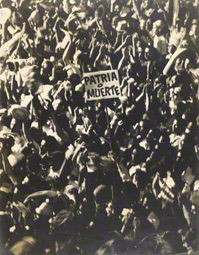
 |
 |
Patria o Muerte (Fatherland or Death), Cuba, Osvaldo Salas, negative, January 1959; print, 1984. © The Osvaldo and Roberto Salas Estate, Havana, Cuba
|
 |
This well-known image associated with the Revolution was made shortly after the movement's triumph. The populist fervor for the new state is effectively captured and conveyed here by one of the nations most important photographers, Osvaldo Salas, who framed this patriotic sign amid a celebratory crowd.
Beginning in 1959, mass gatherings at places like the Plaza de la Revolución in Havana were a recurring feature of the revolutionary government's reign and provided ample opportunity for photographers to document its leaders and popular support.
|
 |
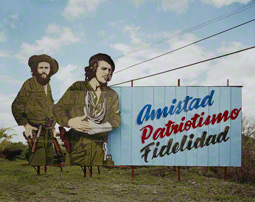
 |
 |
Roadside Billboard in Santa Clara, Virginia Beahan, 2002. The J. Paul Getty Museum. Gift of Michael and Jane Wilson. © Virginia Beahan
|
 |
 |
Soviet troops began to withdraw from Cuba in September of 1991. The collapse of the Soviet Union later that year would have dramatic effects on the nation. The island soon found itself isolated and adrift, without political or military anchors and devoid of subsidies. Fidel Castro declared a "Special Period" (período especial), marked by food rationing, energy conservation, and a decline of public services.
In the nearly 20 years since the Soviet withdrawal, Cubans have managed to survive through perseverance, the forging of new political relationships, and the easing of Socialist systems. This period of transition, which continues today with the recent transfer of power from Fidel Castro to his brother Raúl, has attracted the attention of photographers from around the world. This section of the exhibition looks at the work of three photographers with diverse approaches: Virginia Beahan, Alex Harris, and Alexey Titarenko.
In 2001, Virginia Beahan began a multiyear project on Cuba, photographing its topography in search of remnants of the island's diverse past—such as the roadside billboard shown above. Beahan's Cuba is a land of contradictions, full of disappointments and hope, decay and rejuvenating beauty, simultaneously anchored to the past while looking beyond the present.
|
 |
 |

 |
 |
Small Appliance Repair Shop, Calles 19 and 8, Vedado, Havana, Alex Harris, October 12, 2002. The J. Paul Getty Museum. © Alex Harris
|
 |
 |
|
A former student of Walker Evans, Alex Harris made several trips to Cuba following the collapse of the eastern bloc.
Through distinct vantage points, Harris probed the country's propensity for ingenuity as it underwent great transition—demonstrated in this view of a dilapidated appliance repair shop, in which a repairman works attentively to fix a broken fan.
This image is one from Harris's study of the ubiquitous representations of revolutionary hero José Martí, who championed the cause of Cuban independence and died in the war with Spain in 1898. Portrait busts of Martí are still found in public places, as well as homes, throughout Cuba, often with other symbols of the Revolution.
|
 |
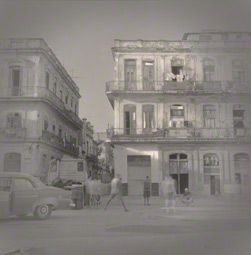
 |
 |
Untitled (Havana), Alexey Titarenko, 2003. The J. Paul Getty Museum. © Alexey Titarenko
|
 |
 |
Alexey Titarenko's photographs describe the conditions of life in Cuba, depicting people persevering amid varying states of ruin—collecting food rations, fixing long-outmoded cars, or playing baseball, as here. Born and raised in Leningrad (now Saint Petersburg), Russia, Titarenko became fascinated with Cuba in 2003, when he made his first trip to Havana.
Titarenko's photographs, like many others in this exhibition, probe the relationship between Cuba's revolutionary past and its uncertain future.
|
 |






